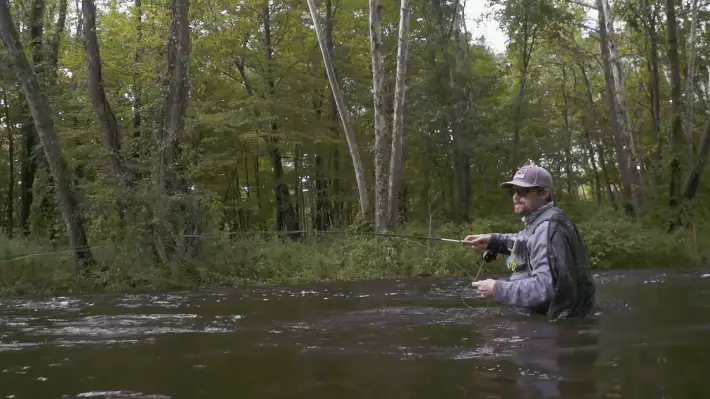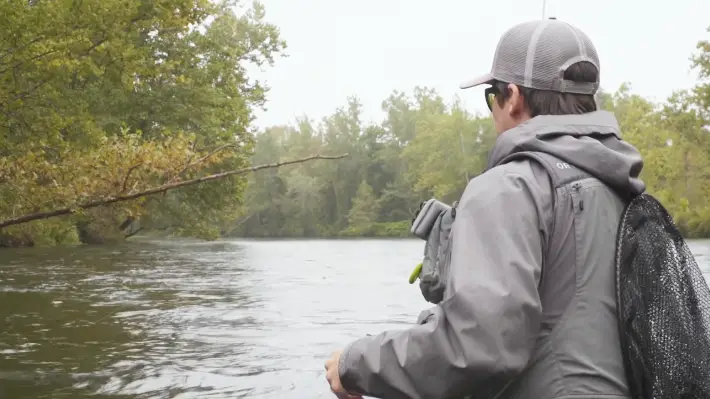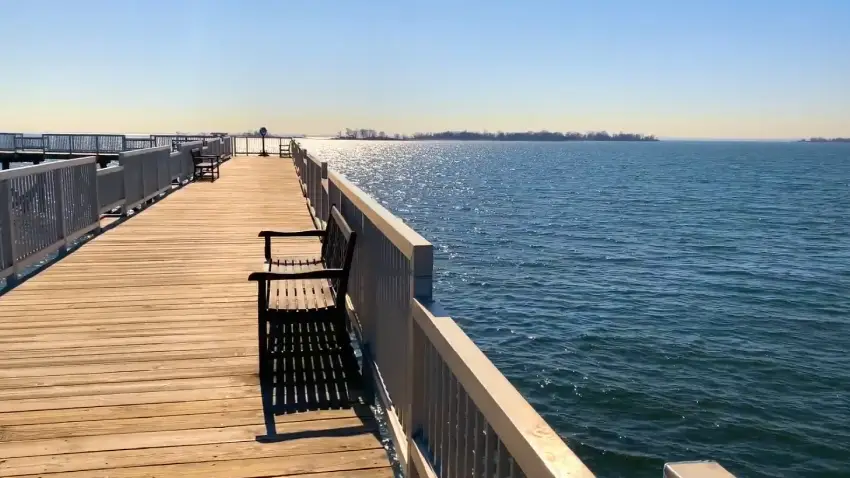Key Takeaways:
- Connecticut has a variety of fly fishing spots, each with its own unique characteristics, making it an attractive destination.
- There’s a wide range of fish to target in Connecticut, including Brown Trout, Rainbow Trout, Atlantic Salmon, Smallmouth Bass, Brook Trout, Pike, Striped Bass, Bluefish, Black Sea Bass, Flounder, and False Albacore.
- Fly fishing in Connecticut is best during spring, summer, and fall. Fishing for Atlantic salmon in winter offers unique opportunities.
- Connecticut fly fishing regulations set by the state’s Department of Energy & Environmental Protection (DEEP).
- Anglers must obtain the appropriate fishing license, which varies based on factors such as residency status and the type of fishing intended.
List of Connecticut’s Top 14 Fly Fishing Spots

The picturesque landscapes of Connecticut are dotted with rivers, each offering a unique fly fishing experience. Here are the top 14 fly fishing spots in the Constitution State, each with its own charm and specialties.
- Farmington River
- Housatonic River
- Mianus River
- Naugatuck River
- Salmon River
- Moosup River
- Kent Falls Brook Trout Park
- Shetucket River
- Quinnipiac River
- Pomperaug River
- Compo Beach
- Fort Trumbull State Park
- Norwalk River
- Saugatuck River
1. Farmington River
- Located in northwest Connecticut, spanning 46.7 miles and extending into southwest Massachusetts through its tributaries.
- Known for its prolific trout population, it’s stocked with 40,000 trout annually.
- Start your adventure at the 3.5-mile-long Upper Trout Management Area for an ideal spot to target large brown trout.
2. Housatonic River
- Flows across western Massachusetts and western Connecticut, meandering for approximately 149 miles through this scenic region.
- Famous for offering some of the finest trout fishing on the East Coast and white-water rafting.
- Provides diverse aquatic life, including Rock Bass, Smallmouth Bass, and Brown Trout.
3. Mianus River
A 20.3-mile-long river that flows through both New York and Fairfield County, Connecticut.
Famous for its spring and fall fly-fishing opportunities, dependent on rainfall and water levels
Take advantage of early stonefly hatches in February and March for a rewarding experience.
4. Naugatuck River
- Stretching 40.2 miles through Connecticut, it flows through the western part of the state, ending in Derby.
- Considered a “trophy trout stream” with substantial trout size.
- Be prepared with a 7 or 9-weight rod, backing, and a strong drag system for the rapid waters.
5. Salmon River
- Located about 1 mile west of North Westchester, Connecticut, formed at the confluence of the Blackledge and Jeremy rivers.
- Open year-round, providing excellent opportunities for newly stocked trout.
- Use Adams and Caddis fly patterns and opt for a 5 or 6-weight rod for successful fishing.
6. Moosup River
- Flows through the U.S. states of Rhode Island and Connecticut and extends approximately 23.7 miles (38.1 km) through the region.
- Heavily stocked with brown and rainbow trout, catch and release in the lower section.
- Various access points include East Main St, Water St. Bridge, River Street Road and Barber Hill.
7. Kent Falls Brook Trout Park
- Part of the Housatonic Valley, situated within Kent Falls State Park, which is a public recreation area located in the town of Kent, Connecticut.
- Stocked with around 1300 trout annually, making it an excellent location for beginners.
- Opt for dry flies in the calm pools for a productive experience.
8. Shetucket River
- A 20.4-mile tributary located in eastern Connecticut, the Shetucket River merges with the Thames River.
- It hosts a variety of salmonid species, including rainbows, brook trout, Atlantic salmon, and big brown trout.
- Experiment with fly patterns like Double Bunny, Zoo Cougar, and Autumn Splendor to maximize your catch.
9. Quinnipiac River
- A 45.5-mile-long river situated entirely within the state of Connecticut in the New England region of the United States.
- Recovered from past pollution, now stocked with 2500 trout annually.
- Ideal for lightweight tackle in its calm waters and nymph flies in deeper sections.
10. Pomperaug River
- Stretching 13.4 miles, meanders through the U.S. state of Connecticut, confluent with the Nonnewaug River in Woodbury.
- Stocked with approximately 9600 trout annually, it is designated a “trophy trout stream”.
- Medium tackle is recommended for this waterway with diverse fish species.
11. Compo Beach
- A picturesque 29-acre park, nestled along the shoreline of Long Island Sound and bordered by the Saugatuck River.
- Ideal for fly fishing for striped bass, bluefish, scup, tub gurnard, and summer flounder.
- Choose Clouser Minnow, Gurglers, and Surf Candy fly patterns for successful saltwater fly fishing.
12. Fort Trumbull State Park
- Situated on the shores of Long Island Sound, Fort Trumbull State Park offers a prime location for anglers in Connecticut.
- Features diverse saltwater fishing opportunities.
- Gurglers, Clouser Minnow, and Surf Candy fly patterns are effective for saltwater fly fishing here.
13. Norwalk River
- Originating in Ridgefield, Connecticut, the Norwalk River is fed by ponds that empty into the town’s 500-acre “Great Swamp.”
- Features stocked trout and healthy populations for angling.
- Recommended flies include Flashback Pheasant Tail, Baetis Barr Emergers, and Caddis Larva.
14. Saugatuck River
- A 23.7-mile river in southwestern Connecticut, USA.
- Known for its brown, rainbow, and brook trout.
- Effective fly patterns like Zebra Midge, Prince Nymph Jigged, and Pheasant Tail Jigged cater to the river’s trout populations.
When is the best time for Connecticut fly fishing?
The ideal time for fly fishing in Connecticut largely depends on the season and the specific location you plan to fish.
Spring: In the spring, particularly from April to May, you’ll find excellent opportunities for fly fishing, with rising water temperatures and hatches of aquatic insects.
Many of Connecticut’s rivers, including the Farmington, Naugatuck, and Shetucket, offer great fishing during this season. Early morning and late afternoon are usually the prime times when fish feed actively.
Summer: As the weather warms up in the summer, you can continue to enjoy fly fishing. With its cooler waters from the dam releases, the Farmington River is a popular choice during the summer months. Early mornings and late evenings are ideal for fly fishing to avoid the day’s heat.
Fall: The fall season, from September through November, is considered prime time for trout fishing in Connecticut.
Rivers like the Housatonic and Shetucket become even more attractive as the cooling temperatures trigger the trout’s feeding frenzy. It’s a beautiful time to be on the water, with the added bonus of vibrant fall foliage.
Winter: For those interested in winter fly fishing, the Naugatuck River offers a unique experience with Atlantic salmon fishing.
The catch-and-release season for salmon runs from October through November, and from December to March, you can keep one salmon per day. Winter fly fishing requires appropriate gear and clothing to stay comfortable in the cold weather.
What fish species can you catch in Connecticut through fly fishing?

You can target a wide variety of fish species through fly fishing. Some of the most popular fish to catch on the fly include Brown Trout, Rainbow Trout, Atlantic Salmon, and Brook Trout.
In addition to these species, you may also encounter Pike, Smallmouth Bass, Striped Bass, Flounder, Bluefish, Black Sea Bass, and False Albacore while fly fishing.
What are the fly fishing rules and regulations in Connecticut?
In Connecticut, the rules and regulations governing fly fishing are overseen by the Connecticut Department of Energy & Environmental Protection (DEEP). Here’s what you need to know:
Licensing: To engage in fly fishing, you will need a fishing license. The type of license you require depends on factors such as your residency status and the type of fishing you intend to do.
For instance, licenses are available for residents aged 16-17 and 18+, as well as non-residents.
Species and Catch Limits: Different species targeted for fly fishing may have specific regulations regarding the number and size of fish you can catch. Regulations may dictate certain species’ minimum and maximum sizes, such as trout and bass.
Location-Specific Rules: Various bodies of water in Connecticut may have distinct regulations. For example, Trout Management Areas, Trophy Trout Areas, and Sea-run Trout Streams may have varying rules for catch and release, creel limits, and allowable fishing methods.
Private Property Rights: When fly fishing in rivers and streams, it’s vital to respect the rights of private property owners.
Public access may be restricted to designated rights-of-way or require landowners’ permission. Comprehending and adhering to the access rules in your chosen fishing areas is essential.
Permit Requirements: Certain fishing-related activities, such as participating in fishing tournaments or scientific collections, may necessitate special permits.Fishing regulations in Connecticut change often, so you’ve got to stay up to date on the latest ones. The Connecticut DEEP website is the primary resource for accessing the state’s latest updates and details on fly fishing regulations.

